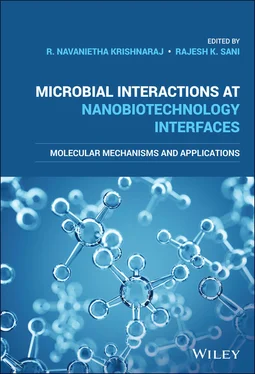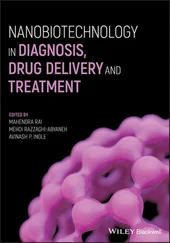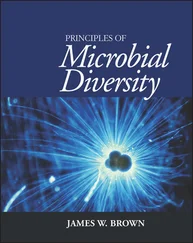Microbial Interactions at Nanobiotechnology Interfaces
Здесь есть возможность читать онлайн «Microbial Interactions at Nanobiotechnology Interfaces» — ознакомительный отрывок электронной книги совершенно бесплатно, а после прочтения отрывка купить полную версию. В некоторых случаях можно слушать аудио, скачать через торрент в формате fb2 и присутствует краткое содержание. Жанр: unrecognised, на английском языке. Описание произведения, (предисловие) а так же отзывы посетителей доступны на портале библиотеки ЛибКат.
- Название:Microbial Interactions at Nanobiotechnology Interfaces
- Автор:
- Жанр:
- Год:неизвестен
- ISBN:нет данных
- Рейтинг книги:4 / 5. Голосов: 1
-
Избранное:Добавить в избранное
- Отзывы:
-
Ваша оценка:
- 80
- 1
- 2
- 3
- 4
- 5
Microbial Interactions at Nanobiotechnology Interfaces: краткое содержание, описание и аннотация
Предлагаем к чтению аннотацию, описание, краткое содержание или предисловие (зависит от того, что написал сам автор книги «Microbial Interactions at Nanobiotechnology Interfaces»). Если вы не нашли необходимую информацию о книге — напишите в комментариях, мы постараемся отыскать её.
Microbial Interactions at Nanobiotechnology Interfaces — читать онлайн ознакомительный отрывок
Ниже представлен текст книги, разбитый по страницам. Система сохранения места последней прочитанной страницы, позволяет с удобством читать онлайн бесплатно книгу «Microbial Interactions at Nanobiotechnology Interfaces», без необходимости каждый раз заново искать на чём Вы остановились. Поставьте закладку, и сможете в любой момент перейти на страницу, на которой закончили чтение.
Интервал:
Закладка:
1.3.2.2 Organic‐Based NMs
The NMs formed from proteins, lipids, carbohydrates, and other organic substances are termed as organic‐based NMs, which are generally 10 nm to 1 μm in size. Commonly exploited organic NMs are dendrimers, liposomes, micelles, and polymeric NPs. The superior advantage of these systems over the other NM systems is because of their biodegradable and nontoxic nature. Some of these materials like micelles, liposomes, and polymeric NPs have hollow core also called as nanocapsules, which are being exploited for loading and delivery of drug molecules (Biswas et al., 2013; Tiwari, Behari, & Sen, 2008). Apart from that, these materials are sensitive to heat and light, which can be used as platform for responsive and targeted drug delivery system. Similarly, the surface of dendrimers has many chain ends that can also be engineered for specific chemical functions and targeted delivery. Owing to the aforementioned properties coupled with their structural stability, structural integrity, and controlled release profile, organic NMs have emerged as a promising drug delivery system (Wei et al., 2015).
1.3.2.3 Inorganic‐Based NMs
The NMs that are based on metal, metal oxide, and ceramic are called inorganic NMs.
1.3.2.3.1 Metal‐Based NMs
Nanometer‐sized particles that are synthesized from the metal either by constructive or destructive routes are metal‐based NMs. Most of the metals can be synthesized in form of NMs (Salavati‐Niasari, Davar, & Mir, 2008); however, the most extensively studied metal‐based NMs include cadmium, aluminum, silver (Kim et al., 2007), iron, gold (Sun & Xia, 2002), copper (Ramyadevi et al., 2012; Ruparelia et al., 2008), and lead‐based NMs. The size of these materials varies from 10 to 100 nm with high surface area‐to‐volume ratio, unique surface charge, and pore size. Further, they can be either amorphous or crystalline, which can exist in different sizes and shapes such as spheres, and cylinders.
1.3.2.3.2 Metal Oxide‐Based NMs
Metal‐based NMs are sensitive to environmental factors such as heat, sunlight, moisture, and air. In order to overcome the demerits of metal NMs, metal oxide‐based NMs were synthesized. One of the most common examples of metal oxide NPs are iron oxide NPs, which are synthesized from the oxidation of iron particles at room temperature. The metal oxide NPs are preferred over metal NPs due to their increased reactivity and efficiency (Tai et al., 2007). Routinely employed metal oxides include: magnetite (Sun & Zeng, 2002), iron oxide, aluminum oxide (Mukherjee et al., 2011), silicon dioxide, titanium dioxide, zinc oxide (Sharma, Jandaik, Kumar, Chitkara, & Sandhu, 2016), cerium oxide, and copper oxide (Ren et al., 2009).
1.3.2.3.3 Composite‐Based NMs
In general, composite materials are described as materials with two or more different materials combined to blend the properties of all the constituent materials. In the same way, the composite‐based NM is a multiphase material with at least one of the dimensions in nanoscale, which is obtained by combining one NM with other or blending one NM with bulk or larger material to form a NM (Vollath, 2013). Bones and the eggshells are the best examples of naturally occurring composite NMs. These NMs generally possess highly improved physical, chemical, mechanical, and biological properties in comparison to their constituent materials. Nanocomposite materials can be of different combinations such as metal/metal, metal/ceramic, carbon/carbon, and ceramic/ceramic (Jeevanandam et al., 2018).
1.3.3 Classification Based on Origin
Based on their origin, NMs are classified as natural and synthetic NMs. The NMs that are produced by biological species or anthropogenic activities in nature without human intervention are called natural NMs. The NMs formed in nature are present throughout earth's atmosphere, hydrosphere, and lithosphere. This may include the NMs present in whole troposphere, oceans, sea, rivers, lake, groundwater, rocks, lava, soils, even microorganism, and higher organisms (Hochella, Spencer, & Jones, 2015; Sharma et al., 2015). Synthetic NMs are the NMs that are synthesized through physical, chemical, biological, or hybrid methods besides the materials that are produced from engine exhaust, smoke, and mechanical grinding (Wagner et al., 2014). Even though synthetic NMs are more advantageous as aforementioned, the major problem is predicting the fate and behavior of the materials in the environment. Currently there are a lot of strategies to perform the risk assessment of the synthetic NP in various environmental conditions. Still extrapolating the behavior of synthetic NMs from existing knowledge is a major challenge.
1.4 Application of NMs
NMs have found broad applications in various fields such as nanofluids, medical sectors, in cutting tools, automotive sector, wear, and corrosion‐resistant coatings. The engineering of NMs to form lighter, as well as extremely stronger materials has found its application in making hard and strong surface coating over material as resistive coatings, faster acting switches, medicines, storage devices with enhanced storage capacity and in building materials.
1.4.1 Advanced Application of NMs as Antimicrobial Agents
Apart from the above applications, NMs have been employed in the medical field as both theragnostic and diagnostic agents. Gold NPs are well‐known for their application in the medical field whereas silver NPs have found applications as antimicrobial materials. Apart from silver, in recent times, a number of NMs have gained attention as antimicrobial agents in the healthcare sector because of the development of resistant bacteria caused by the uncontrolled usage of antibiotics. Antimicrobial‐resistance is considered one of the critical issues that need an immediate solution. In this regard NMs with unique features and specific functionality have gained interest in combating antimicrobial resistance. In the following sections, we will briefly explain bacterial resistance and the role of NMs in bacterial resistance.
1.5 Bacterial Resistance to Antibiotics
The most serious threat to public health are infectious diseases and mortalities that have resulted from chronic infections. The common causative agents for most infectious diseases are bacteria. Before the discovery of antibiotics, the old treatment modalities involved the use of synthetic compounds such as sulfa drugs, quinolones, and salvarsan as chemotherapeutic agents (Aminov, 2010). Later on, in the twentieth century antibiotics emerged as wonder drugs. However, the wild use of antibiotics with uncontrolled measures led to the emergence of antibiotic‐resistant pathogens and the foremost dangerous multidrug‐resistant strains.
The first antibiotic resistance was reported with the enzyme called penicillinase produced from pathogenic Escherichia coli (Abraham & Chain, 1940). In nature, the organism that produces antibiotics has self‐resistance against its own antibiotic. Most of them have more than one simultaneous mechanism to protect the cells completely from their own bioactive molecules. The most common mechanism of self‐resistance involves antibiotic modification or degradation, antibiotic efflux, antibiotic sequestration, and target modification. In the producer organisms, the genetic code for the self‐resistances are clustered with the antibiotic synthesis gene and hence their expression is co‐regulated. The widespread use of antibiotics and coexistence of antibiotic producer organism with nonproducers led to the origin of antibiotic resistance (Kaur & Peterson, 2018). Since NMs have shown potential to deal with antibiotic resistance, a brief discussion on the mechanism of antibiotic resistance is included in this section.
Читать дальшеИнтервал:
Закладка:
Похожие книги на «Microbial Interactions at Nanobiotechnology Interfaces»
Представляем Вашему вниманию похожие книги на «Microbial Interactions at Nanobiotechnology Interfaces» списком для выбора. Мы отобрали схожую по названию и смыслу литературу в надежде предоставить читателям больше вариантов отыскать новые, интересные, ещё непрочитанные произведения.
Обсуждение, отзывы о книге «Microbial Interactions at Nanobiotechnology Interfaces» и просто собственные мнения читателей. Оставьте ваши комментарии, напишите, что Вы думаете о произведении, его смысле или главных героях. Укажите что конкретно понравилось, а что нет, и почему Вы так считаете.












